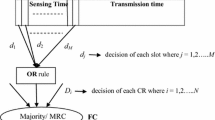Abstract
This study aims the throughput maximization of carrier sense multiple access (CSMA) in random access cognitive radio networks (CRNs) by using cooperative spectrum sensing. In the cooperative spectrum sensing, multiple cognitive radio (CR) users individually monitor the spectrum for the primary users (PUs)’ activities and send their local decisions to the CR access point. Upon receiving the individual decisions, the CR access point gives the final decision about the PU’s presence at the spectrum and sends it to all CR users in the network. At decision stage, CR access point utilizes the k-out-of-N decision fusion rule with optimal k value in order to obtain maximum CRN throughput. In this paper, we model a CRN utilizing CSMA medium access control scheme and focus on analyzing the throughput performance of it. Throughput performances of our CRN model which separately utilizes AND, OR, MAJORITY fusion rules and k-out-of-N decision fusion rule with the optimum k value are obtained and compared under the same network level probability of detection constraint. The throughput results obtained show that our CRN model utilizing k-out-of-N decision fusion rule with the optimum k value achieves higher throughput performance than AND, OR and MAJORITY fusion rules when they all have the same CRN load.






Similar content being viewed by others
References
Mitola, J., et al. (1999). Cognitive radio: Making software radios more personal. IEEE Personal Communications, 6(4), 13–18.
Haykin, S. (2005). Cognitive radio: Brain-empowered wireless communications. IEEE Journal on Selected Areas in Communications, 23(2), 201–220.
Akyildiz, I., Lee, W. Y., Vuran, M. C., & Mohanty, S. (2006). NeXt generation dynamic spectrum access cognitive radio wireless networks: A survey. Computer Networks Journal, 50(13), 2127–2159.
Cormio, C., & Chowdhury, K. R. (2009). A survey on MAC protocols for cognitive radio networks. Ad Hoc Networks, 7, 1315–1329.
Akyildiz, I., Lo, B., & Balakrishnan, R. (2011). Cooperative spectrum sensing in cognitive radio networks: A survey. Physical Communication, 4, 40–62.
Zhang, W., Mallik, R. K., & Letaief, K. B. (2009). Optimization of cooperative spectrum sensing with energy detection in cognitive radio networks. IEEE Transactions on Wireless Communications, 8(12), 5761–5766.
Kramer, G., Maric, I., & Yates, R. D. (2006). Cooperative communications. Foundations and Trends in Networking, 1(3–4), 271–425.
Chen, Q., Liang, Y.-C., Motani, M., & Wong, W.-C. L. (2011). A two-level mac protocol strategy for opportunistic spectrum access in cognitive radio networks. IEEE Transactions on Vehicular Technology, 60(5), 2164–2180.
Peh, E., Liang, Y.-C., Guan, Y. L., & Zeng, Y. (2009). Optimization of cooperative sensing in cognitive radio networks: A sensing-throughput tradeoff view. IEEE Transactions on Vehicular Technology, 58(9), 5294–5299.
Liang, Y.-C., Zeng, Y., Peh, E. C. Y., & Hoang, A. T. (2008). Sensing-throughput tradeoff for cognitive radio networks. IEEE transactions on Wireless Communications, 7(4), 1326–1337.
Yu, H. G., Tang, W. B., & Li, S. Q. (2011). Optimization of cooperative spectrum sensing with sensing user selection in cognitive radio networks. EURASIP Journal on Wireless Communications and Networking, 2011(208), 1–8.
Yucek, T., & Arslan, H. (2009). A survey of spectrum sensing algorithms for cognitive radio applications. IEEE Communications Surveys & Tutorials, 11(1), 116–130.
Quan, Z., Cui, S., Poor, H. V., & Sayed, A. H. (2008). Collaborative wideband sensing for cognitive radios. IEEE Signal Processing Magazine, 25(6), 60–73.
Vistotsky, E., Kuffner, S., & Peterson, R.(2005) On collaborative detection of TV transmissions in support of dynamic spectrum sharing. In Proceedings of IEEE Symposium on New Frontiers in Dynamic Spectrum Access Networks (DySPAN), Baltimore, MD, pp. 338–345.
Mishra, S., Sahai, A. & Brodersen, R. (2006). Cooperative sensing among cognitive radios. In Proceedings of IEEE international conference on communication, Istanbul, Turkey, pp. 1658–1663.
Rom, R., & Sidi, M. (1990). Multiple access protocols: Performance and analysis. New York: Springer.
Althunibat, S., Renzo, M. D., & Granelli, F. (2013). Optimizing the K-out-of-N rule for cooperative spectrum sensing in cognitive radio networks (pp. 1607–1611). Atlanta, GA, USA: IEEE GLOBECOM.
Cardenas-Juarez, M., Pineda-Rico, U., Stevens-Navarro, E., & Ghogho, M. (2015). Sensing-throughput optimization for cognitive radio networks under outage constraints and hard decision fusion. In International conference on electronics, communications and computers (CONIELECOMP ‘15), pp. 80–86, IEEE, Cholula, Mexico, 2015.
Maleki, S., Chepuri, S. P., & Leus, G. (2013). Optimization of hard fusion based spectrum sensing for energy-constrained cognitive radio networks. Physical Communication, 9, 193–198.
Acknowledgments
The authors would like to thank Prof. Murat Torlak for his valuable discussions and suggestions during the course of this work. This research has been supported by a grant from The Scientific and Technological Research Council of Turkey (TUBITAK-BIDEB 2219).
Author information
Authors and Affiliations
Corresponding author
Rights and permissions
About this article
Cite this article
Atmaca, S., Şayli, Ö., Yuan, J. et al. Throughput Maximization of CSMA in Cognitive Radio Networks with Cooperative Spectrum Sensing. Wireless Pers Commun 92, 1473–1492 (2017). https://doi.org/10.1007/s11277-016-3616-y
Published:
Issue Date:
DOI: https://doi.org/10.1007/s11277-016-3616-y




